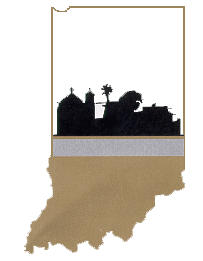 |
Indiana
Farmstead Assessment for Drinking Water Protection
Livestock Yards Management
|
 |
Use this survey to assess the risk to water quality posed by
your livestock yard. In this survey, the term "yard" refers to an open lot
or a barn/lot combination. If your livestock are in confinement housing, this
survey does not apply. If you have more than one livestock yard, answer the
survey questions as they apply to the yard closest to the water well. Circle
the answer that best describes your livestock yard. At the end of each section
sum the numbers that correspond to each answer for the section total. When
you have completed the survey sum the section totals for the risk assessment
score. Refer to Fact Sheet 8 for more information on livestock yards management.
For each question, a (1) represents a higher risk to drinking
water than a (3).
Location
& Site Characteristics
1. How far is your livestock yard from:
a water well?
less than 50 feet (1)
between 50 and 100 feet (2)
more than 100 feet (3)
a surface water?
less than 50 feet (1)
between 50 and 100 feet (2)
more than 100 feet (3)
a tile inlet?
less than 50 feet (1)
between 50 and 100 feet (2)
more than 100 feet (3)
2. Is the yard located upslope from:
a water well?
Yes (2)
No (3)
a surface water?
Yes (2)
No (3)
a tile inlet?
Yes (2)
No (3)
3. How deep is the soil layer in the livestock yard?
less than 20 inches (1)
between 20 and 30 inches (2)
more than 30 inches (3)
4. Describe the soil texture in the livestock yard.
clay (3)
loam (2)
sand (1)
5. Describe the drainage of the soil in the livestock yard.
poor (2)
good/moderate (3)
excessive (1)
Location & Site Characteristics section total __________
Surface
Water Diversion & Lot Runoff Control
6. Does any upslope surface water run through the yard?
Yes (3)
No (2)
7. Is the roof water collected and diverted from the yard?
Yes (2)
No (3)
8. Does the yard have curbs?
Yes (3)
No (1)
9. Do you collect and store the runoff from the livestock yard?
Yes (3)
No (1) If No, skip Question 10
10. Do you use an infiltration strip to receive runoff from the yard?
Yes (3)
No (1)
11. Do you separate the solids out of the runoff?
Yes (3)
No (1)
Surface Water Diversion & Lot Runoff Control section total _________
Yard
Cleaning & Yard Size
12. How often do you clean and scrape the livestock yard when animals
are present?
at least weekly (3)
at least monthly (2)
rarely (1)
13. What is the area of the livestock yard in square feet? ___________
(Yard width ___ feet x Yard length ___ feet)
14. What is the maximum number of animals kept on the yard at a time?
_______ animals 15. What is the total area of the yard in use?
_______ ft2/animal
(Divide the answer to Q 13 by the answer to Q 14)
16. Use the table below to determine your risk rating for livestock
yard size. For each type of animal you keep on a yard (paved or
earthen) compare your answer to Question 15 with the size listed in
the table. The table values are in area (ft2) of yard needed per
animal. If your yard size is equal to or greater than the table
listing, your score is 3. If your yard size is smaller than the table
listing, your score is 2.
------------------------------------------------------------------------------
animal paved ft2 earthen ft2 score
------------------------------------------------------------------------------
dairy cows 75 400 ___
dairy replacements 40 150 ___
beef feeders 50 500 (300 with a mound) ___
beef cows & heifers 60 600 (400 with a mound) ___
sheep & ewes 20 40 ___
feeder lambs 10 25 ___
hogs & sows 30 150 ___
growing/finishing pigs 30 150 ___
horses exercise yard > 2,500 ___
turkeys on range = 290-175 per acre ___
ducks on range = 290-175 per acre ___
------------------------------------------------------------------------------
Yard Cleaning & Yard Size section total _________
Risk
Assessment for Livestock Yards Management
Add the following totals:
Location & Site Characteristics section total ____ x 3 = _____
Surface Water Diversion & Lot Runoff Control section total ____ x 2 = _____
Yard Cleaning & Yard Size section total = _____
Survey 8 Score _______
----------------------------------------------------------------------
Low Moderate High
126 - 109 110 - 70 71 - 42
----------------------------------------------------------------------
for fact sheet 8, click here
Livestock Yards Management
Fact Sheet
| Reviewed 5/1/01 |
|
It is the policy of the Purdue University Cooperative Extension Service,
David C. Petritz, Director, that all persons shall have equal opportunity
and access to its programs and facilities without regard to race, color,
sex, religion, national origin, marital status, parental status, sexual
orientation, or disability. Purdue University is an Affirmative Action
employer. This material may be available in alternative formats. 1-888-EXT-INFO.
|

